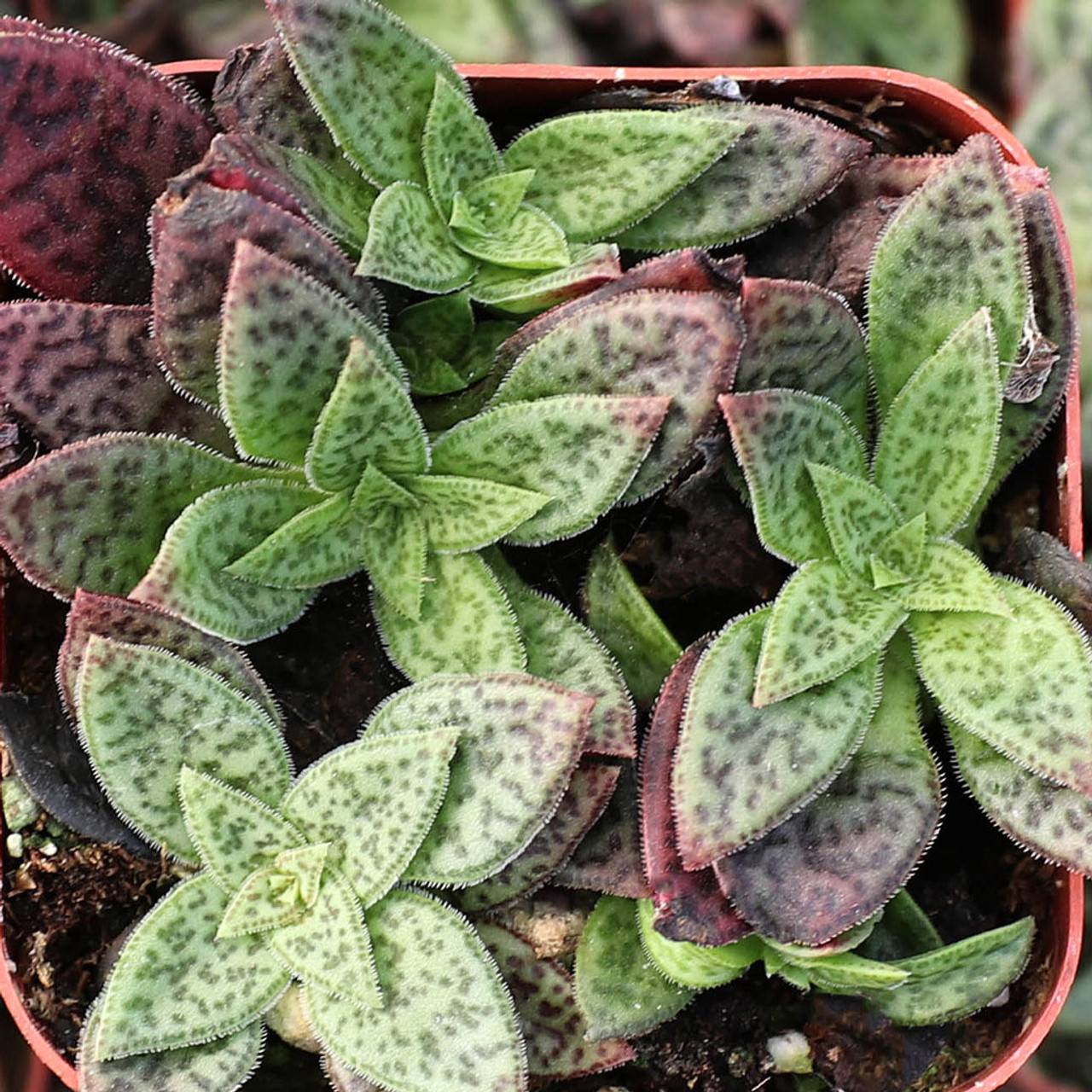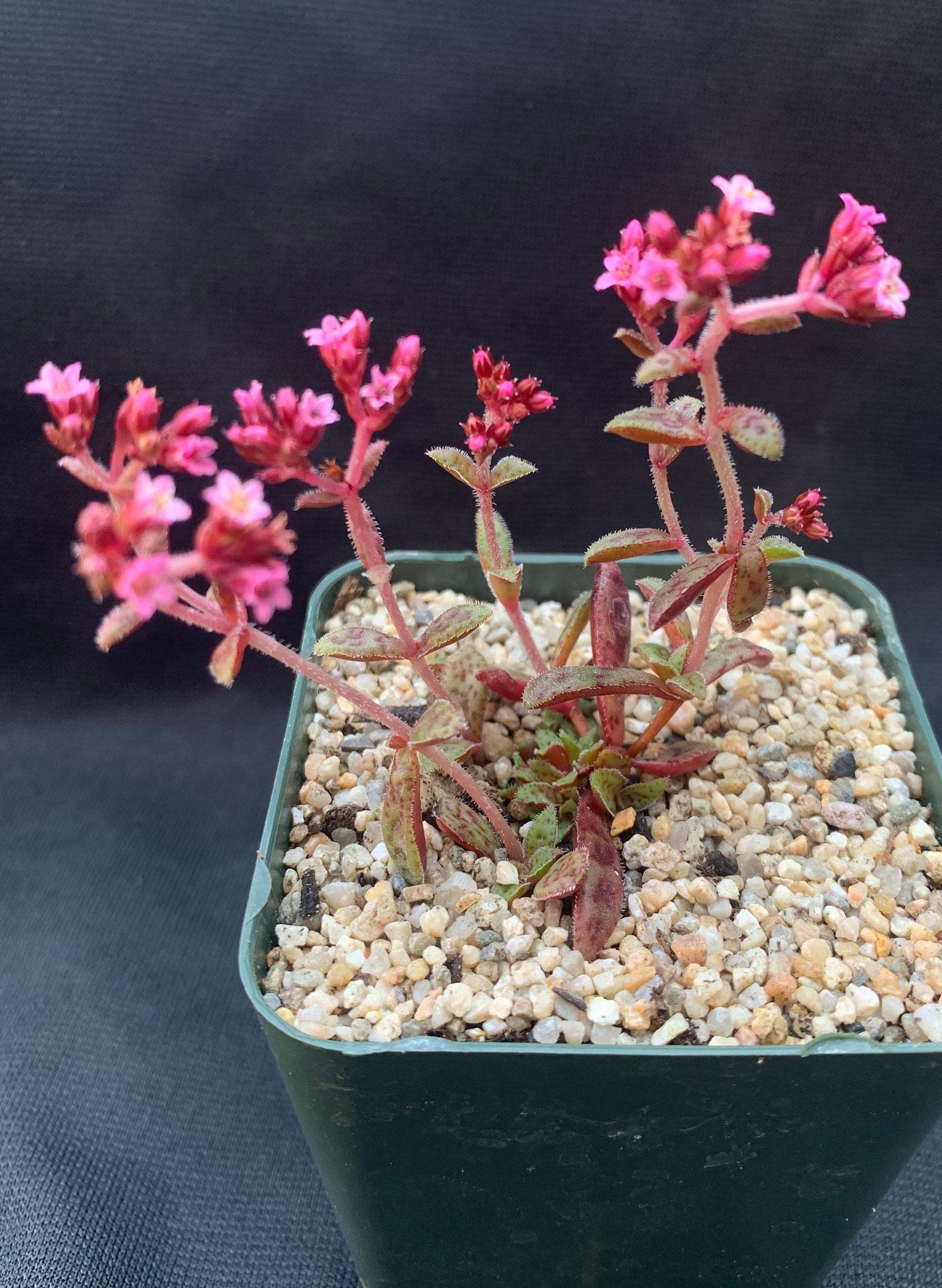This small succulent has triangular, green leaves with dark green markings, which are why it is known as “Tiger Jade.” Its undersides can have a pink to purple hue, and it can be grown both inside and out. If kept outdoors, it will display its lovely pink colouring more prominently, and can even bear white to pink flowers in the spring.
Table of Contents
Care and Propagation Information
This succulent is a low-growing, spreading plant that is perfect for rock gardens. Its leaves grow out in small clusters on thin stems, which form mounds as the plant matures. The Crassula exilis ssp. cooperi “Tiger Jade” variety is especially beautiful.
This plant is low maintenance and can thrive indoors or outdoors, and can be propagated with ease. However, be aware that it can be vulnerable to mealybug infestations.
Watering
Crassula exilis ssp. cooperi requires typical care for a succulent; the “soak and dry” method is recommended, with the soil drying out completely between waterings.
Be sure to grab our complimentary watering guide to help you understand the signs of overwatering in your succulents and how to rectify the situation.
Where to Plant
If you are located in an area with temperatures below 30° F (-1.1° C), it is recommended to grow Tiger Jade in a pot or container that can be brought inside when temperatures drop. This succulent does well when exposed to direct or partial sunlight.
How to Propagate Crassula exilis ssp. cooperi “Tiger Jade”
Crassula exilis ssp. cooperi “Tiger Jade” can be propagated using stem cuttings, leaf pieces, and seeds.
Cuttings
To propagate ‘Tiger Jade’, use a clean, sharp knife or pair of scissors to take a stem cutting from the main plant. Allow the stem to dry and harden for several days before planting it in a soil that has good drainage. Water the cutting only when the soil becomes completely dry.
Leaves
Put the leaf in water, and wait for roots to appear.
Propagating “Tiger Jade” is a simple process. Select a strong and healthy leaf from the main plant and remove it by carefully twisting it from the stem without any remaining leaf material. If some of the stem is attached to the leaf, that’s okay. Place the leaf in water and wait for the roots to sprout.
Allow the leaf’s cut end to heal and scab over for a few days before placing it on top of soil that drains well. Make sure to water it only when the soil is completely dry. Once the leaf has sprouted roots and a rosette, and the parent leaf has withered, transplant the new growth into the soil.
Seeds
If you want to grow from seed, the best time to sow them is during the fall in soil that drains well. If you live in an area with a climate zone of 9a or higher, you can sow the seeds directly outdoors. If you live in a cooler region, you should start by planting the seeds indoors and providing them with a grow light.
Care and Propagation Information
General Care for Crassula exilis ssp. cooperi “Tiger Jade”
This plant is low maintenance and can thrive indoors or outdoors, and can be propagated with ease. However, be aware that it can be vulnerable to mealybug infestations.
Watering
Crassula exilis ssp. cooperi requires typical care for a succulent; the “soak and dry” method is recommended, with the soil drying out completely between waterings.
Be sure to grab our complimentary watering guide to help you understand the signs of overwatering in your succulents and how to rectify the situation.
Where to Plant
If you are located in an area with temperatures below 30° F (-1.1° C), it is recommended to grow Tiger Jade in a pot or container that can be brought inside when temperatures drop. This succulent does well when exposed to direct or partial sunlight.
How to Propagate Crassula exilis ssp. cooperi “Tiger Jade”
Crassula exilis ssp. cooperi “Tiger Jade” can be propagated using stem cuttings, leaf pieces, and seeds.
Cuttings
To propagate ‘Tiger Jade’, use a clean, sharp knife or pair of scissors to take a stem cutting from the main plant. Allow the stem to dry and harden for several days before planting it in a soil that has good drainage. Water the cutting only when the soil becomes completely dry.
Leaves
Put the leaf in water, and wait for roots to appear.
Propagating “Tiger Jade” is a simple process. Select a strong and healthy leaf from the main plant and remove it by carefully twisting it from the stem without any remaining leaf material. If some of the stem is attached to the leaf, that’s okay. Place the leaf in water and wait for the roots to sprout.
Allow the leaf’s cut end to heal and scab over for a few days before placing it on top of soil that drains well. Make sure to water it only when the soil is completely dry. Once the leaf has sprouted roots and a rosette, and the parent leaf has withered, transplant the new growth into the soil.
Seeds
If you want to grow from seed, the best time to sow them is during the fall in soil that drains well. If you live in an area with a climate zone of 9a or higher, you can sow the seeds directly outdoors. If you live in a cooler region, you should start by planting the seeds indoors and providing them with a grow light.
FAQ
How much watering does Crassula need?
Place in a sunny or lightly-shaded spot, and feed once a month with a balanced liquid fertiliser throughout the growing season.
How do I know if my Crassula needs water?
If the plant’s leaves are falling off, shriveled, or have brown spots on them, this suggests that the plant needs increased water intake. If, however, the leaves become overly soft and squishy, this indicates that the plant is receiving too much water.
How do you water a Crassula?
For crassula plants, it is best to give them deep, but rare, waterings and let the soil dry out between them. During the warm months of spring and summer, they will require more water than in the cooler fall months.
How often do you water Haworthia Cooperi?
Haworthia plants are known for their ability to conserve water, so they don’t need to be watered frequently. It’s best to wait until the soil has been dry for several days before adding more water, which could be every two weeks or more often depending on the temperature and climate.
How do you care for Crassula Cooperi?
Paraphrase: – Light Requirements: Direct sunlight. Ensure your plant is placed in a spot that receives plenty of sunlight throughout the day.
– Watering Need: Low. Make sure the soil has dried out before you water.
– Fertilizing Need: Minimal.
– Utilize the Planta app to get personalized care instructions tailored to your plant.



